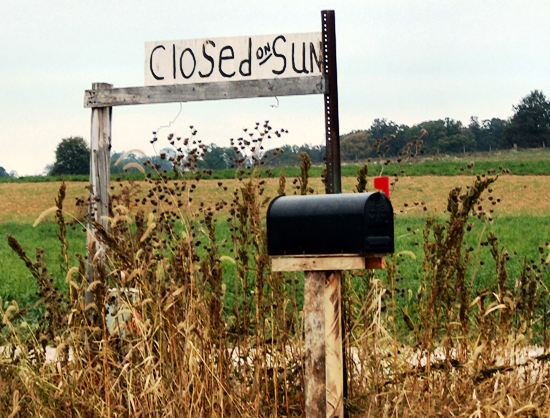Colorado Amish expansion, and the Amish in 2060
A recent news item looks at a new Colorado Amish furniture and variety store which has opened in Fremont County (central CO).
Partners Joe Nissley and Paul Schmucker of the P & J Hitching Post have sourced all their goods to Amish producers, with furniture, quilts, and “denim-works” coming from both local and Midwestern sources.
 They’re also doing food, with bread, cookies and baked goods, plus 13 varieties of jam homemade in the Monte Vista, CO Amish settlement. With toys and home decor also available, this is one-size-fits-all Amish shopping.
They’re also doing food, with bread, cookies and baked goods, plus 13 varieties of jam homemade in the Monte Vista, CO Amish settlement. With toys and home decor also available, this is one-size-fits-all Amish shopping.
And when you think about it, it makes sense that an Amish store in a new area might carry all manner of Amish-made products (whereas stores in large settlements may be able to do well specializing in one category). With few local Amish outlets, more items here means more chances to send a customer home happy, and for the business to grow. More on Amish furniture in Denver.
Glimpsing the future?
I love these stories of pioneer businesses in new Amish areas. They make me wonder what Amish communities will look like in the future, even many years from now, when everyone reading this will be long gone.
Colorado still has just a small Amish population, but evidence shows Amish here making positive moves–both to migrate to the state (see the PBS Amish documentary for a fascinating example) as well as to develop their businesses and secure an economic foothold, as in the case with P & J here.
Who knows if the Amish will continue to thrive in Colorado–other states have seen Amish arrive, do well for a short period, then leave for any number of reasons–but I hope that’s the case.
If I live to my life expectancy of around 80 (not quite 50 years from now), and Amish growth rates stay the same, I should see a time when there will be over 1 million Amish in North America.
In 2060, how many Amish will call Colorado home? Will Pennsylvania and Ohio still be the leading Amish states? Where will Amish be living that they aren’t today? These are just a few of the questions that come to mind.







I could imagine that the Amish population could very easily hit the one million mark in 2060, but then again the earths population will have increased considerably by that time as well. The big question for me is “will anyone still be around” in 2060 with world events the way they are, and what kind of quality of life will there be? Richard
We have visited with the Amish in Colorado. They really seem to love the area they are in, and they are making a good impact on the area. We go to their shops when we can and give them our support (but they are a couple hours away from where we live).
I do hope they continue growing in number in Colorado. However, I believe they provide a positive influence wherever they are.
I see a possible hole in your 1 million Amish projection. When Amish are progressive, they rarely are able to stop progressing towards ‘the world’ until they get there. Whole communities may vanish as Amish, mostly likely becoming Mennonites first. Many Indiana Amish have changed a great amount in the 13 years that I have been observing them. Where these are large communities, I do not believe they can stop the march to the english world. For written evidence of what I am saying, I refer again the Paton Yoder book “Tradition and Transition”. This book describes the minister gatherings in the 1860s. Those Amish that found them helpful and liked them all drifted out of the Amish by about 1900. Those Amish that resisted these gatherings became known as the ‘Old Order’ Amish. I find it very hard to believe that today’s progressive Amish churches will be still be Amish on your 2060 date. Time will tell, will we be able to see how things are in the future? Only God knows.
Projected Amish population
Good point Lance, and there are probably a few holes, as projecting that far out is always going to be tricky. Something like 2/3 of Amish took the progressive path in the late 1800s. I do wonder if the willingness of many churches to accommodate in order to allow people to make a living will make being Old Order Amish attractive enough to keep high growth.
I think this fluidity and flexibility may result in groups that look even less “Amish” compared to today’s most conservative groups but still retaining the key elements like Plain dress, horse-and-buggy travel and German dialect.
There have been quite a few technological concessions in the past half-century yet Amish have been growing strong, and I don’t think they are ascending to a progressive orientation at near the rate as in the 19th century. The lowest Amish may not see mainstream Amish as the “true” Amish but by all other measures they still qualify as Old Order. But time will tell.
"New" Old Order Amish?
Both of you, Erik & Lance, have thought provoking ideas regarding Amish survival to 2060, and beyond.
As I’ve learned in my life (AARP member, not a “young” whipper-snapper”), religion and religious beliefs/customs/etc. all change with the times; after all, it’s people who “run things” here on earth—like when I was a kid and had to fast for 3 hours before receiving communion (Roman Catholic Church). Along came Pope John the XXIII and that and other “rules” changed. As you say, Lance, the minister gatherings of the 1860’s led to the “New” and “Old” Order Amish “division”, if it can be called that. Since each Amish community (what I’d think of as a “Parish”) has its’ own Ordnung, there’s no doubt in my mind that there will be many more changes by 2060, in the Amish “church”. Bishops are people, after all. Will that mean a NEW “Old” or “New” Order Amish split?(And what would it be called, the “Newly Reformed Old Order Amish” or “New-ER Progressive Amish”?) Who’s to say if it’s God who “allows” (or inspires?) these splits to occur? I wouldn’t venture to guess, and don’t want to get into an argument here. I’m just saying, people and their religions change, have done so in the past, and I doubt that’ll change any time soon.
That said, I’ll bet there’ll be some kind of “Amish” in the USA in 2060, and since they’re not making any new land around here (unless you count Hawaii…a few other places still “growing” volcanically), I’ll bet Colorado’s Amish community will have grown exponentially! I won’t be around to see it, so I hope you’ll remember this IF you’re still around then, Erik! 🙂
Alice Mary
Interesting questions, and example from the Catholic Church Alice Mary. I hope I’ll get to see how things turn out myself, though of course not much is certain 🙂
I know one place where the Amish wont be expanding, and that would be the Bronx,lol.Richard
Some questions...
I’m absolutely certain there will be Amish in the year 2060. Their growth is almost entirely from large families, rather than converts, so the high growth rate will undoubtedly continue.
Some questions:
1. In many areas the Amish now primarily work in factories, or own their own businesses. In other words, they don’t farm. Has family size dropped amongst these Amish? In most parts of the world, as people move away from farming their family sizes drop within a generation.
2. Is there an accepted definition of “who is Amish?” We could define them based on outward characteristics (use horse and buggy for transportation, does not use grid electricity in the home). We could also use a theological definition (believes in a ‘living hope’ of salvation rather than a guarantee, does not seek to prosletyze others). Is there a standard way to define the Amish?
3. So far the vast majority of Amish settlements are in the U.S. or Canada, with occasional Mennonite colonization of other areas in the Americas such as Bolivia and Paraguay. What might be the next COUNTRY to receive significant Amish settlement? Any chance that it could be outside of North or South America? I’ve heard one Hutterite settlement in Africa and one in Japan. Might the Amish ever expand far outside the U.S.? Any previous attempts to do so?
Ed,
I agree with you that there will be Amish around still in 2060, and long after, just that few of them will be from today’s progressives, they will have drifted out. I think that New Order Amish will continue, but not really much bigger than they are now. Too many drifting Amish just make a stop there on their way out.
I do believe that as the Amish become a larger and therefore more visible subculture in our America culture, there will be more and more seekers approaching them. I wonder, will one of the commentors here on AA join this summer? (Kate) I know of about 10 by name who have joined and stayed and about that many more who genuinely tried and did not make it, myself included. I think based on the comments here on the blog, the number will continue to grow and accelerate.
I don’t have answers to points 1 or 2.
There was a group of Amish that thought America was becoming the great satan. They moved to Paraguay for a while. That settlement failed. Some came back to America as Old Order Amish, some established a new settlement in Belize as Amish, and others went to the Scottsville, KY Old Order Mennonites. I have heard that some people have tried to establish quasi-Amish settlements with varying degrees of success. Lobelville, TN is one of these settlements and it has been there for quite a while.
Ed, just to chime in on the first question, one study done showed Northern Indiana Amish factory family size shrinking, with about 2 less children vs. farm families 8.6 v. 6.6. This was done with 1980s data, though I there are other indicators that shrinking has happened elsewhere (see Thomas Meyers’ “Lunch Pails and Factories” for that info). It’s not a drastic drop, but a pretty significant one.
As to your second question, the definition for Old Order Amish typically includes things like horse and buggy travel, use of German dialect, plain dress, self-identifying as Amish, and you also assume embodying Amish/Anabaptist values like non-resistance. There are some groups out there who almost hit all of these but are off somewhere and are not really in fellowship with any other Amish churches as a result.
Erik, I think Ed and others here have given you some good fodder for many blogs to come. I’ve enjoyed reading each comment.
A question I have (and Erik may be able to direct me to another blog) is regarding the genetic disorders occurring from shared bloodlines. Has significant enough progress been made in fighting these illnesses? Is there an acceptable way to promote welcoming outsiders to the Amish world with a hope that with new bloodlines these genetic disorders may be eradicated?
Thanks all for your input here at Amish America. I admire you all for our shared compassion and interests.
Genetic disease progress among Amish
Carolyn, thanks for your question, I don’t really know a lot of the details, but what I read regarding the work places like the Clinic for Special Children has done, there seems to be good progress with some diseases. Some of these are so rare that they show up almost primarily among Plain populations. Amish are pretty active in cooperating and participating in studies and in some communities do so pretty regularly.
I think Amish are going to be a lot more likely to encourage inter-communal interaction with other Amish than they are to seek or even welcome outsiders with the genetic diversity motivation in mind. There is awareness of the issue as a society -wide concern but it’s just an easier and less disruptive path to stay within your own, though it may necessitate traveling far afield, especially in some of these smaller communities.
For example after the Texas Amish post a couple weeks back, and hearing that apparently the (shrunken) community as it’s currently compromised is largely related, I began wondering what their young people do and which community(s) they go to to interact with other young people. This issue can be another complicating factor leading to Amish settlements failing.
If the current Amish population is 250,000 and doubles every twenty years, 2032 would see a half million and 2052 would be up to your one million mark. As with money, the first million is the hardest.
One million Amish
You are right Eli, or even a little before 2052 since the pop. is already a little above 250K by latest estimates. I’ve also seen 18 years as a doubling rate, but by about mid-century there should be around 1 million Amish assuming no significant changes.
This will change landscapes and affect small communities around the country, hopefully in most cases for the better. We’ll probably inevitably see more conflict over issues such as recent ones like the school busing, roads, etc. And no doubt certain states will probably be and remain more Amish-friendly than others, shaping where that population develops.
Amish in Colorado
More power to them!! We know the quality of their work. I wish some would come to Tucson with permission to use electricity to keep cool.
That would be quite a permission slip Elizabeth 🙂 though some Amish do visit Arizona there is no one there permanently. Possibly they’re waiting for Amish inventors to create the world’s first “Amish electricity” A/C system? 😉